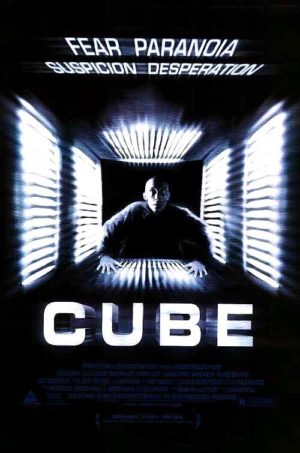 One of the most interesting genre films of the nineties, and certainly one of the most audacious, the 1997 CUBE is a breathtaking display of low budget ingenuity. It was the first feature from Canada’s brilliant, underrated Vincenzo Natali. Interestingly enough, it was released in the US around the same time as Darren Aronofsky’s PI, another mathematically-themed low budget science fiction project. PI received a much warmer reception among critics and audiences, but I say CUBE is the better film.
One of the most interesting genre films of the nineties, and certainly one of the most audacious, the 1997 CUBE is a breathtaking display of low budget ingenuity. It was the first feature from Canada’s brilliant, underrated Vincenzo Natali. Interestingly enough, it was released in the US around the same time as Darren Aronofsky’s PI, another mathematically-themed low budget science fiction project. PI received a much warmer reception among critics and audiences, but I say CUBE is the better film.
A former storyboard artist, Natali proved with CUBE and its follow-ups CYPHER (2002) and NOTHING (2003) that he’s among the most visionary and imaginative filmmakers on the scene. However, Natali was NOT part of CUBE 2: HYPERCUBE (2002) or CUBE 0 (2004), so you can safely skip both.
A man finds himself trapped inside a square room with four sealed portals. He opens one to find another identical room—but when he enters it a wire mesh bursts out of the walls and literally turns him into mincemeat.
A bit later five more people find themselves in a similar (or the same?) room. None know why they’re there, nor exactly where they are—well, all but one: a young guy, an apparent government worker, who reveals he helped build the structure they’re in, a giant cube with several hundred identical square rooms inside. He doesn’t know why he built the thing, an experimental structure created by the government for reasons that are never explained.
As the five people maneuver from room to room, they learn that (as the unfortunate man from the beginning did) select rooms are booby trapped with flame-throwers, wire mesh and sharp blades that jut out from the walls to impale anyone who sets foot inside. To counter this one of the group, a young woman college student, studies a series of numbers on the portal to each room that apparently contain a clue as to whether it’s booby trapped or not; she decides that if the numbers are prime that means the room is deadly (although she later discards that idea).
Another member of the group is a gruff cop with anger issues, who’s helpful at first but grows increasingly antagonistic. There’s also a self-professed escape artist who gives his fellow captives survival tips, an old woman who proves an invaluable morale booster, and an autistic man who joins a third of the way through, and proves to have skills of his own necessary to the group’s continuing survival.
These six people will have to get through the maze of rooms and to the world outside before they starve to death or kill each other. It doesn’t help matters that the properties of the inside of the cube are ever-changing, and that the protagonists’ initial impressions of the structure were all wrong.
Unfailingly gripping and suspenseful, this is a film that utilizes simplicity to its advantage. No concrete explanation is ever given for the cube’s existence or why the protagonists have been placed inside, yet it’s still a satisfying film (unlike the sequels, which over-explain things to the point of tedium). Vincenzo Natali keeps his concentration on elemental matters like basic survival, which take precedence over the numerical angle and so keep the film involving for viewers who aren’t mathematical geniuses (unlike the above-mentioned PI).
The simplicity of the project can blind one to the brilliance of the filmmaking. Natali shot most of the film on an enclosed single set (actually three or four identically designed sets) but keeps it from feeling excessively stagy or claustrophobic. This is due to the acting, which is uncommonly good for a low budget production, and the unusually dynamic staging. Although the rooms the characters traverse all look the same (albeit with differing color schemes), Natali takes care to ensure that all seem distinct; the visuals are styled differently in each, from wobbly handheld camerawork to distorted lenses. It also helps that Natali’s knowledge of film and its properties is evident in the way he skillfully manipulates the depth and space of his sets. Aspiring filmmakers seeking to create visionary cinema with limited means would do well to study CUBE.
Vital Statistics
CUBE
Trimark Pictures
Director: Vincenzo Natali
Producers: Mehra Meh, Betty Orr
Screenplay: Andre Bijelic, Vincenzo Natali, Graeme Manson
Cinematography: Derek Rogers
Editing: John Sanders
Cast: Nicole DeBoer, Nicky Guadagni, David Hewlett, Andrew Miller, Julian Richings, Wayne Robson, Maurice Dean Wint
